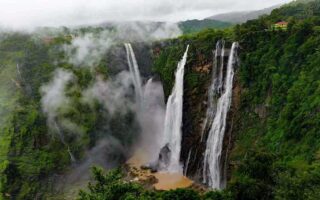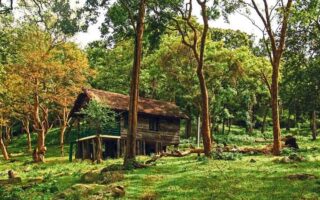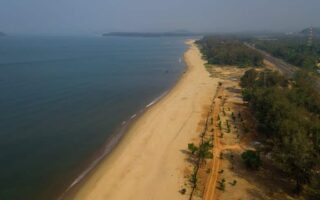India is a wide country and it is blessed with a variety of great flora and fauna. There are many states in India which offer great wildlife experiences to tourists and Karnataka is also one of them. There are many amazing world-famous wildlife sanctuaries in Karnataka which houses a variety of wild animals and vegetation. Some of these sanctuaries offer numerous adventurous activities like jeep safaris, camping, and trekking that attracts a lot of wildlife enthusiasts and nature lovers every year.
Today we have put together a list of 10 best wildlife sanctuaries in Karnataka that every nature lover should visit and find which one entertains them the most. So pack up your bags and enjoy your adventures holidays at some of these wildlife sanctuaries in Karnataka.
Also, don’t miss these amazing Wildlife Tours India if you want a real wildlife experience in India.
Bandipur National Park
- Situated: Bandipur, District of Chamarajanagar, Karnataka, India.
- Known for: The wide collection of natural beauty.
- Entry Timings:
- All days of the week: 6:30 AM – 8:00 AM
- Safari timings: 4:00 PM – 6:30 PM
- Entry fee: Rs.250/-
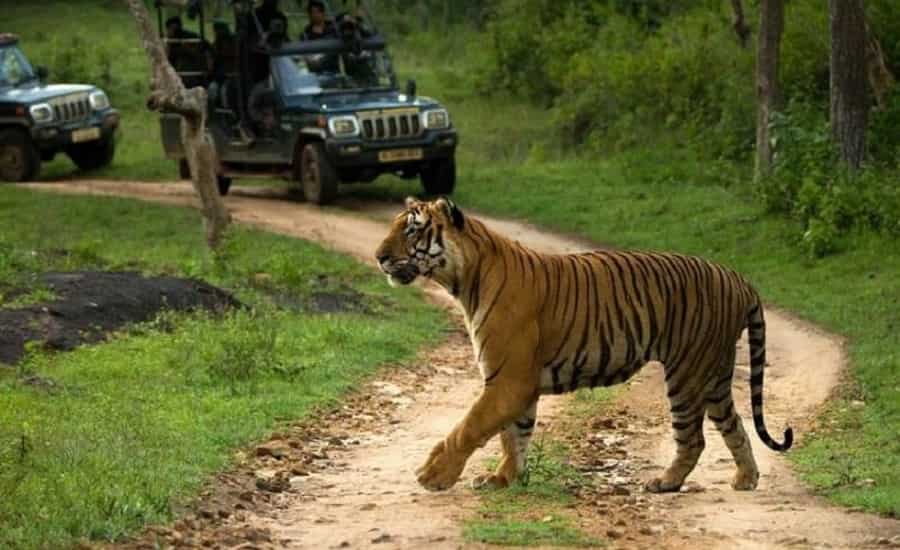
The Bandipur National Park is located about 80 km south of Mysore on the Ooty road. Encompassing 880 sq km of area, it was once the private wildlife reserve of Mysore maharajas. The price of the ticket for Indian and foreigner is Rs.75 and Rs.175 respectively. The video usage charges are Rs. 100. The inhabitants of the park include chitals (spotted deer), sambars, panthers, herds of gaurs (Indian bison), sloth bears and langurs, and communities of tigers and elephants.
With unrestricted traffic rushing down the highway and acts of deforestation disturbing wild life, animals these days have restricted their stroll to safari areas. You can enjoy a brief elephant ride for Rs.100 per person with every elephant carrying a minimum of four people. A safari will cost an Indian Rs.75 and a foreigner Rs.175. The schedule for the safari: 6.30am, 8.30am, 3.30pm & 5.30pm. You can take forest department’s rumbling minibus that is noisy enough to keep the shy creatures away. But it’s better to avail the service of resort vehicles that are permitted to enter into the forest and are comparatively quieter.
Avians at BNP
Bandipur National Park is a home for Peafowl and the list of other birds includes grey Junglefowl, crows and drongos etc. Ornithologists recorded occurrence of 200 species of birds including honey buzzards, red-headed vultures, Indian vultures, flowerpeckers, hoopoes, Indian rollers, brown fish owls, crested serpent eagles and changeable hawk-eagles in the park.
Reptiles at BNP
BNP is a home for different species of reptiles and the list of reptiles at BNP include spectacled cobra, Indian rock python, vipers, rat snake, muggers, monitor lizards, Indian chameleon, Indian pond terrapin, agamids and flying lizards.
Bhadra Wildlife Sanctuary
- Location: Chikmagalur, Karnataka 577101
- Known For: It’s exquisite Tiger Preserve.
- Animals Found: Indian Pond Turtle, Wild Dog, Atlas Moth, Monitor Lizard, Common Garden Lizard, Bronze Backed Tree Snake, Rock Python and flying snake.
- Birds Found: open billed storks, napped black flycatcher, Indian tree pie, great pied hornbill, and great horned owl, king vulture and black winged kite.
- Trees Found: Kindal, Tadasalu, Nandi, Honne, Mathi, Rosewood and Teak.
- Entry Timings: 6:30 AM – 8:30 AM & 4:00 PM – 6:00 PM
- Entry Fee: Vehicle: ₹ 300, Filming: ₹ 150
- Time Require: 1 to 2 hours
Bhadra Wildlife Sanctuary, an important Project Tiger Reserve and protected area, is situated about 38 km (24 mi) to the northwest of the town of Chikmagalur in Karnataka. An exciting place for locals and tourists alike, the region boasts of some exquisite varieties of flora and fauna. The highest peak located in the sanctuary, Hebbe Giri, towers to a height of 1,875 m (6,152 ft) and offers the perfect backdrop for this sightseeing location.
Divided into two adjacent sections : the eastern Baba Budangiri and western Lakkavalli-Muthodi sections; Bhadra Wildlife Sanctuary’s elevation differs from 615 m (2,018 ft) to 1,875 m (6,152 ft). Kallathigiri serves as the highest point on the eastern boundary and is indeed worth a look. This sanctuary stands surrounded by lush rolling hills and the steep slopes of Hebbegiri, Gangegiri, Mullayanagiri and Bababudangiri. Mullayanagiri peak (1,930 metres) is the highest in the Nilgiris and is situated in the Baba Budan Giri Range—that lies in the southeastern precincts of the sanctuary.
Flora and Fauna at BWS
Bhadra Wildlife Sanctuary is a biodiversity hotspot. Most of the area in the BWS comprises dry deciduous forest, moist deciduous forest and semi evergreen forests. BWS comprises the forest at the elevations ranging from 615 m (2,018 ft) to 1,875 m (6,152 ft) above MSL. Forest spread in BWS at higher elevation allows a variety of ecotypes including the unique shola forest/mountain grasslands complex at Bababudangiri and other patches at the altitude of 1,400 m (4,600 ft) above MSL.
Mysore Zoo
- Situated: Indiranagar 570010 Mysore, Karnataka
- Known For: Exquisite range of diverse animal species from all across the globe
- Timings of the zoo: (8.30am to 5.30pm) closed on Tuesdays
- Visit Duration 3 to 4 hours
- Charges: 50Rs for the adults, 20 Rs for children
- Distance: This zoo is just three kms away from the main bus depots and two kms away from the famous Mysore Palace. Local Transports are very easily available for this zoo.
Indulge in the lush ambience of the Mysore Zoo and enjoy the richness of its flora and fauna. This beautiful retreat is an integral part of Maharaja Chamaraja Wodeyar’s royal summer palace and is made all the more picturesque by its backdrop of the stunning Chamundi hills. If you are looking forward to a pleasant outing, then head about 3 km away from the City Bus Stand towards this Zoo. Located 2 km from the Mysore Palace, this interesting sightseeing venue is also referred as the Chamarajendra Zoological Garden and can be found eastern parts of the city.
Flora and Fauna
Mysore Zoo has more elephants than any other Zoo in India. At present there are ten elephants in Mysore Zoo. Many of the elephants of Mysore Zoo were transferred to other Zoos in India. Faunal group of Mysore Zoo includes five green anacondas, contributed by Colombo Zoo along with giraffes, zebras, lions, tigers, white rhinoceroses and baboons, a pair of Red Kangaroos, two lemurs, one pair of Giraffe along with rare species like Sun Bear, Binturong, female Chimpanzee, Indian Rhinoceros, White Peafowl, Hanuman Langurs, Indian Lions, Rhea, Zebra, Red Ibis, Penguins, Baboons and Kangaroos. Visitors can spot native and exotic animal species in natural settings in the Zoo.
There are 1450 animals of 170 species present in the Zoo, they are Gorilla, Chimpanzee, Zebra, Giraffe, African Rhinos, Tapir, Marmoset, Lemur, Baboon, Emu, and Cassowary, Felids, Candies, Bovines, Deer, Antelopes, Primates, Reptiles, Birds etc. Some of the rare species like Polar Bear, Secretary Bird, California Sea Lions and American Bison are also present in this Zoo. The Karanji Lake, a part of the Zoo, attracts about 45 varieties of migrating bird species. Authorities have provided the Boating facility in the Zoo.
Breeding of many exotic animals such as Zebra, Wild beast or Eland Antelope, Barberry Sheep, Emus, Giraffe, Kangaroos achieved successfully in Mysore Zoo and distributed to various zoos in India and abroad. Ornithologists spotted 45 varieties of migrating bird species in the Zoo.
Ranganathittu Bird Sanctuary
- Best time to visit: June – November.
- Distance: The sanctuary is located near Mysore.
- Accommodation: Visitors can accommodate in cottages, resorts at Ranganthittu.
- How to Reach: The sanctuary is easily accessible by road as it is near Mysore, You can reach Ranganthittu Bird Sanctuary.
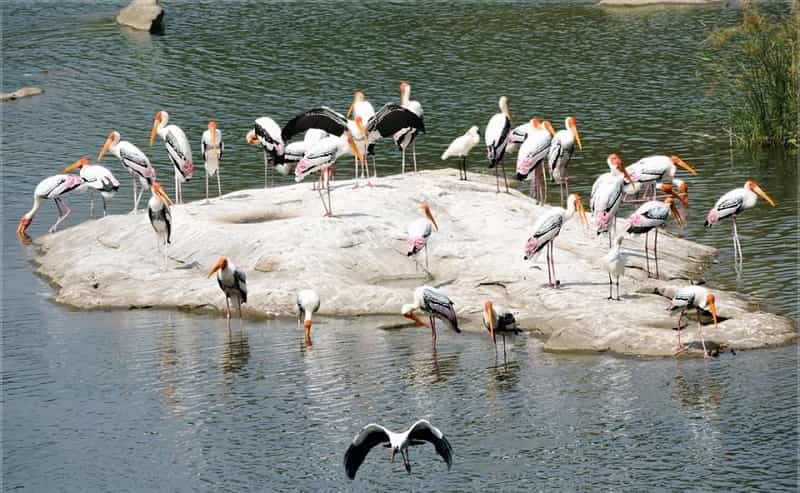
Ranganathittu Bird Sanctuary is popular for inhabiting various types of birds. The bird sanctuary is named after Sri Ranganathaswamy, a Hindu Vishnu God. The sanctuary is declared as a bird sanctuary in the year 1940. An extensive number of migratory birds fly from Siberia, North America and Australia to this place.
Flora and Fauna
Flora: Ranganathittu Bird Sanctuary consists of 400 species of dicotyledonous plants belonging to 79 families. Species such as Fabaceae, Asteraceae, Euphorbiaceae, Acanthaceae, Poaceae, Cyperaceae etc. Medicinal species such as Hemidesmus indicus, Asparagus racemosus, Trichodesma indicum, Hybanthus enneaspermus, Evolvulus alsinoides, Tinospora cordifolia, trianthema portulacastrum, Alangium salvifolium, Gymnema sylvestre, Acalypha indica, Phyllanthus fraternus, Tephrosia purpurea, Boerhavia diffusa, Bacopa monnieri, Scilla hyacinthiana and Cynodon dactylon.
Fauna Includes Painted Stork, Asian Open bill Stork, Common Spoonbill, Woolly-necked Stork, Black-headed Ibis, White Ibis, Lesser Whistling Duck, Indian Shag, Stork-charged Kingfisher and other birds like egrets, cormorants, Oriental Darter, and herons.
Nagarhole National Park
- Location: Kodagu District of Karnataka, 50 km away from Mysore / Mysuru
- Safari Timings:
- Morning 6.00 am to 8.00 am
- Evening 3.00 pm to 5.00 pm for one hour Ride.
- Safari Charges:
- Indian Nationals – Rs. 300/- per person
- Foreign Nationals – Rs.1100/- per person
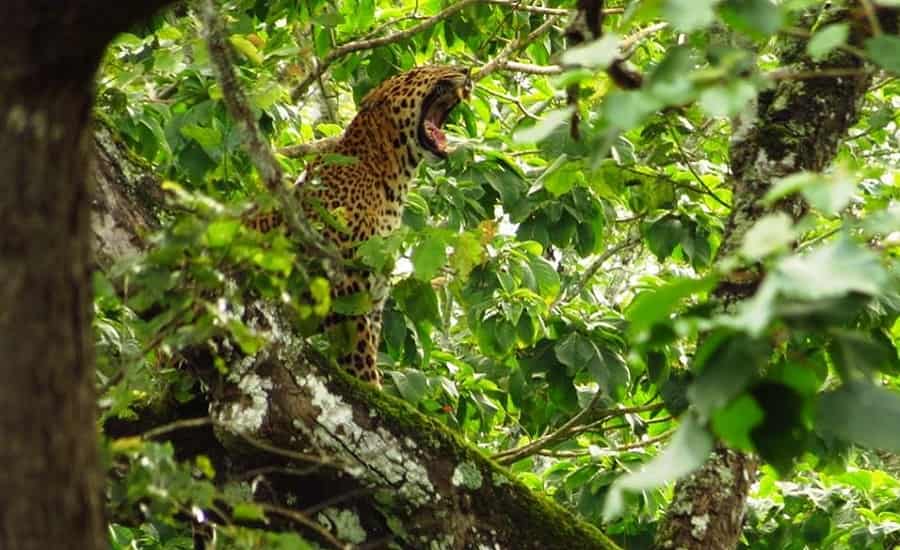
Also known as Rajiv Gandhi National Park, Nagarhole National Park is one of the oldest and largest wildlife sanctuaries in Karnataka. The park is a part of the Nilgiri Biosphere Reserve and is home to a large population of elephants along with tigers, leopards, and other mammals. The park covers an area of more than 640 square kilometers and it is also home to more than 270 species of birds.
NNP – The Habitat of Wildlife, Herbivores and Birds
Nagarhole National Park is inhabited by wildlife animals such as predators like tigers, cheetahs, hyenas, jackals, leopards, wild dogs, wild boars, and sloth bears; and herbivores like barking deer, spotted deer, mouse deer, four-horned antelopes, sambar, elephants, gaurs or wild bison, jungle cats, giant squirrels, civets, otters, common langur, mongoose, giant flying squirrels, hares. Herbivores are those animals that chiefly feed on grass and other plants. The Park also has an over 250 varieties of beautiful birds like blue-bearded bee-eaters, scarlet minivets, Malabar whistling thrushes, common ospreys, herons and ducks are some of the species of birds present in the park. Marsh crocodiles, monitor lizards, rock pythons and several other species of frogs, insects also inhabit this beautiful Nagarhole National Park.
Cauvery Wildlife Sanctuary
- Distance: Located near Muthathi Village, South Bangalore.
- Specification: Apart from flora and fauna the sanctuary is known for inhabiting Mahseer fish.
- Best time to visit: Between May – November
- Accommodation: Hotel services for visitors are provided with various camping accommodations in the sanctuary.
Cauvery Wildlife Sanctuary is located near south of Bangalore. The sanctuary is close to river Cauvery, the name of the sanctuary is taken from the river. Cauvery wildlife sanctuary covers an area of 102.59 sq.km. The sanctuary holds varied vegetation and flora.
Flora and Fauna
Flora: Includes trees like Terminalia Arjuna and Syzygium Cumini. Tamarind, Hardwickia Binata, Acacia Amara, Feronia sp., Ficus sp. And other vegetations are seen here.
Fauna: Includes panther, elephant, wild pig, sambar, spotted deer, woofing deer, four-horned pronghorn, Malabar goliath squirrel, grizzled titan squirrel, normal otter, and rabbit.
How to Reach
- By Air: Nearest airport is at Bangalore.
- By Rail: Nearest railhead is at Mysore.
- By road: All roads have well connection from main areas to the sanctuary, you can reach Cauvery Wildlife Sanctuary.
Bannerghatta National Park
- Location: Bannerghatta National Park (BNP) is located 22 km away from Bangalore city of Karnataka State in India. It is 150 km away from Mysore and 399 km away from Mangalore cities of Karnataka State.
- Timings: 09:00 AM to 05:00 PM except on Wednesdays
- Entry Fee at Zoo: ₹80 for Indian, ₹400 for Foreign Nationals
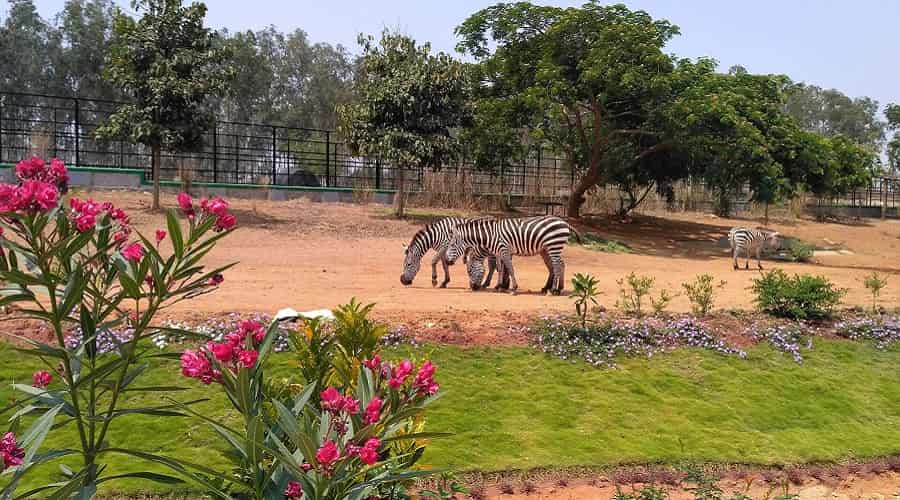
Bannerghatta National Park is one of the most beautiful wildlife sanctuaries in Karnataka. The park is famous because of its rarely found species of white tigers that attracts many wildlife lovers in the park. The park is divided into two sections according to herbivores and carnivores.
Flora and Fauna
Scientists have spotted and recorded occurrence of different species of trees and plants, which includes a few of the medicinal species also in the BNP. The list of plants and tree varieties found at BNP includes Narcissus latifolia, Schleichera oleosa, Terminalia tomentosa, Sandalwood, Neem, Terminalia arjuna, Grewiatilaefolia, Santalum album, Tamarind, Bamboo, Eucalyptus, Bauhinia, Purpurea, Samanea saman and Peltophorum pterocarpum. Forest biologists found fauna group, which includes elephants, gaur, leopard, jackal, fox, wild boar, sloth bear, Sambar, Chital, spotted deer, barking deer, common langur, bonnet macaque, porcupine, hares, wild boar, Pangolin, slender Loris, monitor lizard, cobras, python, Russell’s viper, Krait etc. Similarly ornithologists found different species of birds in the BNP.
Best time to visit
Bannerghatta National Park is open throughout the year, but the best time to visit the park is between the months of September to January. Visitors will be permitted to enter the park between 09:00 AM to 05:00 PM. Authorities have arranged a Boating, Safari and AC Bus Service in BNP. Visitors may need to pay an entry fee fixed by authorities for different facilities in the BNP.
Kudremukh National Park
- Location: Kudremukh National Park (KNP) is located in the Chikmagalur district of Karnataka. It is approximately 145 km (90.09 miles) away from Chikmagalur which is also called as Chikkamagaluru in Karnataka.
- Entry Fee: INR200 for Indian and INR 1,000 for foreign tourist
- Timings: 6:00 AM to 6:00 PM.
Kudremukh National Park is one of the most beautiful national parks in Karnataka. Surrounded by huge steep cliffs, deep valleys, and green mountains, Kudremukh National Park houses a large population of Lion-tailed macaques and a wide array of birds and other animals that pulls so many tourists every year here.
Flora and Fauna at KNP
Kudremukh National Park is a home for different species of plants, trees, birds and wild animals. The floristic composition of the park includes different species of plants and trees. Wild animals found in the park includes Malabar civets, wild dogs, sloth bears and spotted deer. Ornithologists recorded occurrence of different species of birds living in the national park.
Best time to visit KNP
The KNP is open throughout the year. But the best time to visit the park is during the period of October to May, immediately after the monsoon when everything is lush green, and the rivers, streams and waterfalls are at their best. Visitors are advised to get in touch with officials of the park for complete information on entry timings and fee etc.
- Must Read: Popular Hill Station in Karnataka
Dandeli Wildlife Sanctuary
- Location: Dandeli Wildlife Sanctuary (DWS) is located in Uttara Kannada District of Karnataka State. It is 57 km away from Dharwad and 75 km away from Hubli cities of Karnataka State and 150 km away from Goa city of Goa state.
- Timings: 06:00 AM to 06:00 PM
- Entry Fee: Indian Nationals: ₹40, Foreign Nationals: ₹80
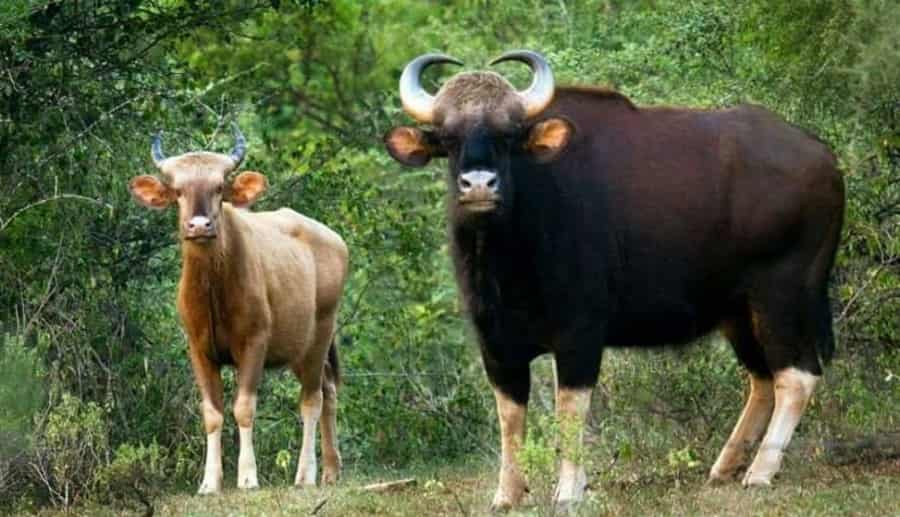
You’ll appreciate the rich greenery as well as its fauna in Dandeli Wildlife Sanctuary. This sanctuary is an ideal place for bird lovers as it has a great population of different bird species. The sanctuary is a piece of Anshi Dandeli Tiger Reserve and is also home to the Great Hornbill and the Malabar Pied Hornbill. Dandeli Wildlife Sanctuary is also home to a rarely found species of Blank Panthers and even it is the only wildlife sanctuary in Karnataka where Black Panthers are spotted.
Flora and Fauna at DWS
Scientists have recorded occurrence of different species of trees and plants, which includes the medicinal species in the sanctuary. Ornithologists spotted more than 300 species of birds in the DWS and the main avifauna group includes 4 species of Hornbill out of 9 found in the world along with Blue throated barbet, peregrine falcon, curious looking, Malabar and so on. Visitors can spot different species of mammals like sloth bears, Barking deer, Indian pangolin, Malabar giant squirrel and Ratufa Indica in the DWS.
Best time to visit Dandeli Wildlife Sanctuary
Dandeli Wildlife Sanctuary is open throughout the year, but the best time to visit the DWS is between the months of March to October. Visitors can enter the park between 06:00 AM to 06:00 PM. Dandeli Wildlife Sanctuary Authorities have arranged many activities in the wildlife sanctuary, they are White Water Rafting, Dandeli Repelling, Dandeli Trekking, Dandeli Jacuzzi, Dandeli bird watch, Dandeli Safari, Dandeli Fishing and Dandeli Night out Camp along with Dandeli Island Visits, and Dandeli Tribal Visits etc. Visitors can take the help of Tourist Guide to watch different places in the DWS.
Brahmagiri Wildlife Sanctuary
- Address: located at Karnataka.
- Specification: Apart from vegetation and animals 250 types of birds are seen here.
- Best time to visit: Between October and May
- Accommodation: Hotel services are available for accommodation.
Brahmagiri Wildlife Sanctuary is covered with semi and evergreen forests. The eastern tip of the Sanctuary touches the northwestern edge of the Nagarahole National Park.
Flora: Brahmagiri Wildlife Sanctuary consists of species such as Anogeissus latifolia, schleichera oleosa, terminalia tomentosa, terminalia arjuna, grewia tilaefolia, santalum album, shorea talura, emblica officinalis, vitex altissima, wrightia tinctoria, randia sp., zizphus sp. and albizzia sp. Common species such as eucalyptus, bauhinia purpurea, samanea saman and peltophorum pterocarpum are also found here.
Fauna: Includes elephant, gaur, tiger, bush feline, panther feline, wild puppy, sloth bear, wild pig, sambar, spotted deer, lion-tailed macaque, langur, slim loris, cap macaque, normal langur, woofing deer, rodent deer, Malabar mammoth squirrel, goliath flying squirrel, Nilgiri marten, regular otter, tan mongoose, civets, porcupine and pangolin. Python, cobra and lord cobra are a percentage of the snakes discovered in the Sanctuary.
How to Reach
- By Air: Mangalore is the nearest airport.
- By Rail: Mysore is the nearest railhead.
- By Road: This sanctuary is well connected by roads, you can reach Brahmagiri Wildlife Sanctuary
Kabini Wildlife Sanctuary
- Location: 60 km from Mysore
- Safari Timing:
- Morning Safari – 06.30 am – 09.00 am
- Evening Safari – 3.30pm – 6.00 pm.
- Entry Fee: ₹500 for Indians, ₹1700 for Foreign Nationals
- Best time to Visit: October to February
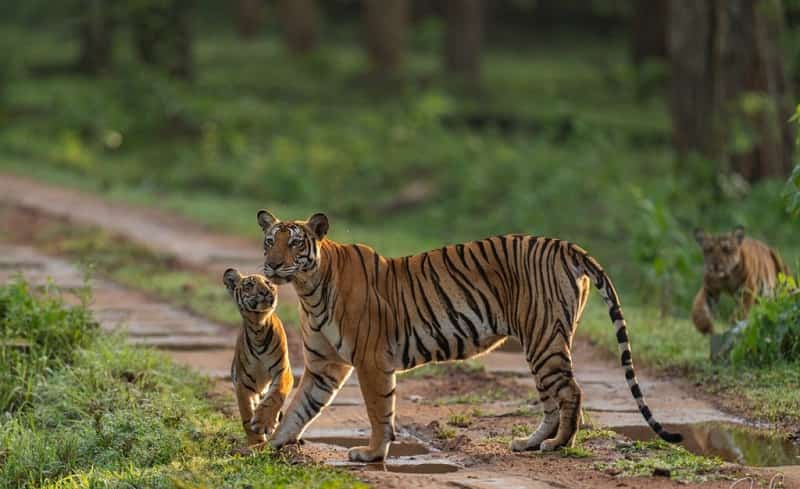
Another best wildlife sanctuary in Karnataka, Kabini is said to be the individual hunting ground for the ancient Maharajas of Mysore and for the British’s too. Situated around 200 kilometers from Bangalore, Kabini is home to more than 250 different varieties of great flora and fauna and considered as one of the best wildlife sanctuaries in Karnataka.
The sanctuary is famous for having a huge population of Asiatic Elephants along with a good density of Tigers too.
Bheemeshwari National Park
- Location: 100km away from Bangalore
- Timings: 6:00 a.m and 5:00 p.m
- Best time to Visit: During monsoon
The National Park of Bheemeshwari, located between the look alike falls of Mekedatu, Gaganachukki and Barachukki falls, is an ideal place for the wildlife tour in the state of Karnataka. At this place, travellers can come crossways an extensive diversity of animals, like
- Leopards
- Crocodiles
- Jackals
- Monkeys
- Wild Boars
- Deer’s
- Elephants
So that was our list of 12 best wildlife sanctuaries in Karnataka that every wildlife lover should visit for an exciting wildlife holiday in India. If you have ever visited some of these wildlife sanctuaries in Karnataka then share your experience with us in the comment section below.
